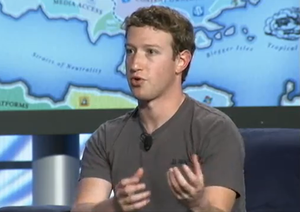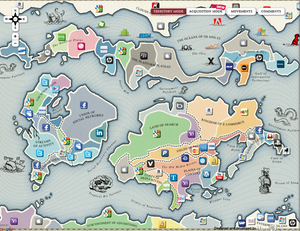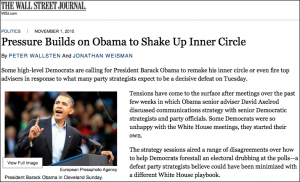 When I first heard the phrase “iPad newspaper” — shorthand for Rupert Murdoch’s not-so-secret-any-more new project — I puzzled over its oxymoronic implications. Forget about the, you know, iPad/paper contradiction and think about the business. Murdoch is reportedly spending $30 million on this thing. Could that possibly pay off with a product that’s tethered to a single, new platform? Puzzled, I tweeted, “Will they stop me from reading it on my desktop?”
When I first heard the phrase “iPad newspaper” — shorthand for Rupert Murdoch’s not-so-secret-any-more new project — I puzzled over its oxymoronic implications. Forget about the, you know, iPad/paper contradiction and think about the business. Murdoch is reportedly spending $30 million on this thing. Could that possibly pay off with a product that’s tethered to a single, new platform? Puzzled, I tweeted, “Will they stop me from reading it on my desktop?”
Apparently, the answer is yes. The Guardian writes that this new publication will feature “a tabloid sensibility with a broadsheet intelligence” (funny, that’s pretty much how David Talbot described Salon when we started it!) and tells us:
According to reports, there will be no “print edition” or “web edition”; the central innovation, developed with assistance from Apple engineers, will be to dispatch the publication automatically to an iPad or any of the growing number of similar devices. With no printing or distribution costs, the US-focused Daily will cost 99 cents (62p) a week.
Now, these “reports” (and the Guardian) may be unreliable here; we won’t know for sure till Murdoch unveils his product. But taking these rumors at face value, it sounds like Murdoch intends to deliver his latest news baby into a tablet-only world. A Monday column by David Carr confirms the report and adds some detail: The publication is to be called The Daily, and it will, apparently, be just that: “It will be produced into the evening, and then a button will be pushed and it will be ‘printed’ for the next morning. There will be updates — the number of which is still under discussion — but not at the velocity or with the urgency of a news Web site.” Wonderful! Slower news — and at a higher price.
First, let’s give Murdoch credit for what’s intelligent about this plan. It’s smart to ditch the original “legacy” of paper and the more recent legacy of website publishing — to build something fresh for a new platform rather than do the old shovelware dance. And it’s smart to jump in relatively early, to snag users when the tabula is still rasa.
For Murdoch, I have to imagine there is also something personal about this project. I’m sure he is furious that he has so far failed to extend his record of success and dominance, unbroken in other media, into the digital world. The iPad must look to him like his latest, best, and perhaps last chance to do so, after the humiliating embarrassment of his MySpace investment and the apparent trainwreck of the Times UK paywall.
But how likely is it that any significant number of people will pay $50 a year (or a bit less, assuming a subscription discount) for what is likely to be an above-average but hardly essential or irreplaceable periodical? It’s not as if iPad users have no existing sources of online news, innovative delivery mechanisms for information, or a shortage of stuff to read. iPad users love their browsers; the device is great for reading the free Web.
Murdoch will need more than half a million people to pay that fee to cover a $30M budget (less if he can sell ads), so maybe the thing will work. I’ll bet against it, though, assuming it’s as the Guardian and Carr describe it. I’ll base my bet on the same logic that I’ve long articulated about why paywalls are a bad idea (the problem is not with the “pay” but with the “wall”).
Why do people love getting their news online? It’s timely, it’s convenient, it’s fast — all that matters. Murdoch’s tablet could match that (though it sounds like it may drop the ball on “timely” and “fast”). But even more important than that, online news is connected: it’s news that you can respond to, link to, share with friends. It is part of a back-and-forth that you are also a part of.
Murdoch’s tablet thingie will be something else — a throwback to the isolation of pre-Web publications. Like a paywalled website, this tablet “paper” will discourage us from talking about its contents because we can’t link to it. In other words, like a paywalled site, it expects us to pay for something that is actually less useful and valuable than the free competition.
It’s possible, of course, that the creators of Murdoch’s tablet publication will try to turn it into a true interactive project — where interactive doesn’t mean “buttons you can click on” but rather “people you can interact with.” If they’re smart, they’ll try to build a community within their walls. But that’s a very difficult goal to achieve even if you embrace it wholeheartedly. At big media companies like News Corp., this idea is more often an afterthought than a priority.
Much more likely, the Murdoch project will make the same mistake so many big-media-backed digital ventures have made before. It will assume that its content is so unique, its personality so compelling, its information so rich that readers will regard it as essential. Yet even if it is a really good digital periodical — and it might be! — it is hard to imagine what News Corp. can do to make it that essential, in a world awash in news and information.
(Carr reports that “Initially, there will be a mirror site on the Web to market some of its wares outside the high-walled kingdom of apps.” I’ll bet that over time this mirror site will either grow to be the “real” Daily, as editors realize the free numbers dwarf the pay numbers, or they will pull up the drawbridge completely to try to force a few more customers to pay. It’s Slate 1998 all over again! Will we get Daily umbrellas?)
Now, I know a lot of my friends in journalism are rooting for Murdoch here because they see the pay-for-your-apps iPad model as a deus ex machina that will intervene to save the threatened business model of the old-school newsroom. (Carr’s column weighs the pros and cons here well.)
If you’ve read this far you know I think that’s unlikely. I also think it’s undesirable. On this, I stand with Tim Berners-Lee — who did the primary work in creating the Web two decades ago.
I followed the coverage of Murdoch’s venture around the same time I read Berners-Lee’s great essay on the 20th anniversary of the open Web., I’ll let him have the last word:
The tendency for magazines, for example, to produce smartphone “apps†rather than Web apps is disturbing, because that material is off the Web. You can’t bookmark it or e-mail a link to a page within it. You can’t tweet it. It is better to build a Web app that will also run on smartphone browsers, and the techniques for doing so are getting better all the time.
Some people may think that closed worlds are just fine. The worlds are easy to use and may seem to give those people what they want. But as we saw in the 1990s with the America Online dial-up information system that gave you a restricted subset of the Web, these closed, “walled gardens,†no matter how pleasing, can never compete in diversity, richness and innovation with the mad, throbbing Web market outside their gates. If a walled garden has too tight a hold on a market, however, it can delay that outside growth.
UPDATE: Sam Diaz at ZDNet shares my skepticism. I originally avoided writing here about the angle turning up suggesting that Steve Jobs was personally involved in the NewsCorp Daily project and had loaned Murdoch an engineering team; it appeared to be super-thinly sourced. Diaz agrees. We’ll all know soon enough.
In the meantime, let me take gentle issue with the concern both Diaz and Carr raise about the size of the Daily staff. Diaz asks: “Can a team of 100 reporters covering everything from Hollywood to Washington really dig in deep enough to produce the type of content worthy of that paid subscription?” Short answer: If 100 can’t, then 500 couldn’t, either. Carr: “How do you put out an original national newspaper every day with a staff of only 100?” Short answer: You don’t try to cover everything, but you cover what you do cover so originally and engagingly that people can’t resist.
Come on, people: 100 journalists is a huge newsroom as long as you’re not trying to be a “paper” — er, “tablet” — of record. If anything, it’s too big. The key, of course, lies in who those 100 people are, and how you deploy them. The problems with the Daily don’t lie in how much Murdoch is spending or how many bodies he’s hiring, but rather with some of the central premises of the project.









